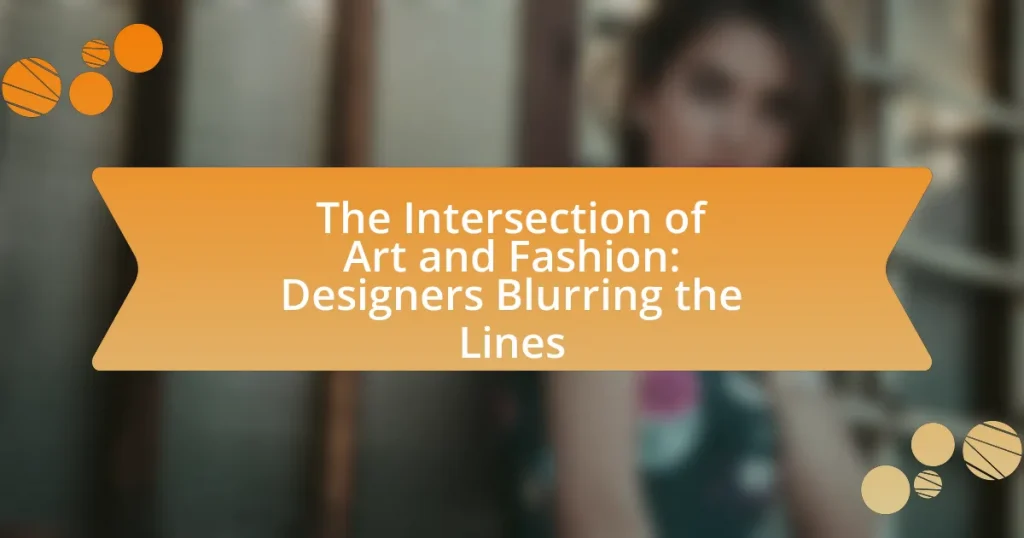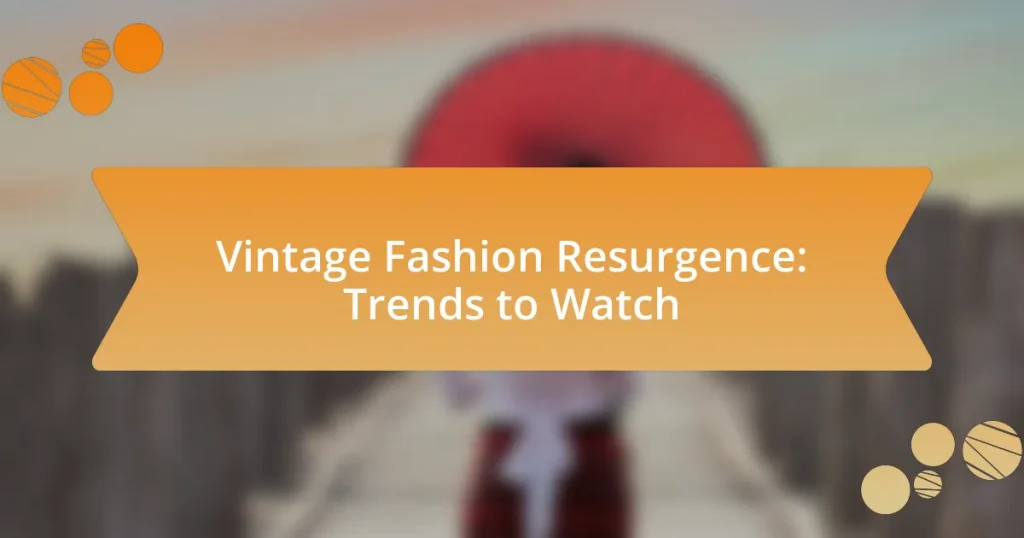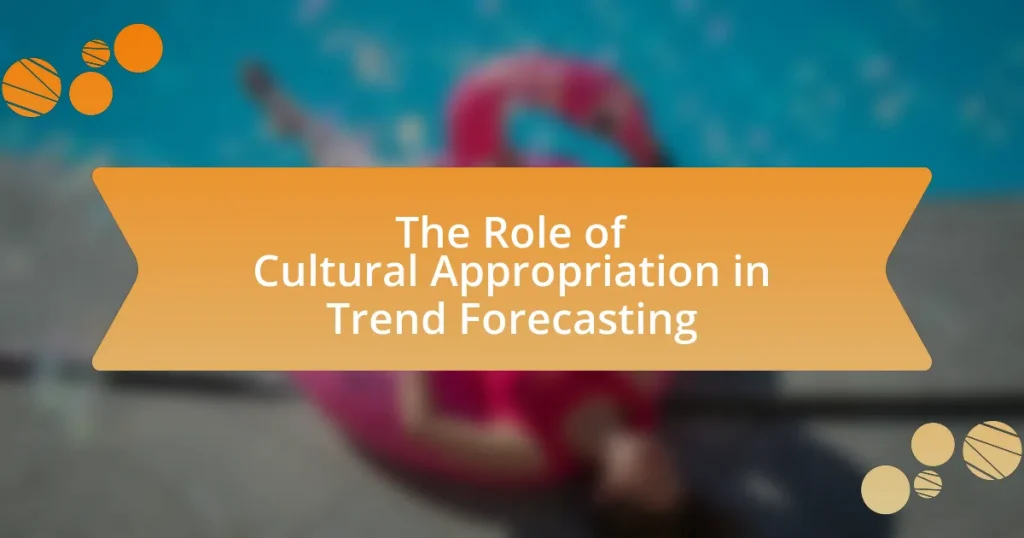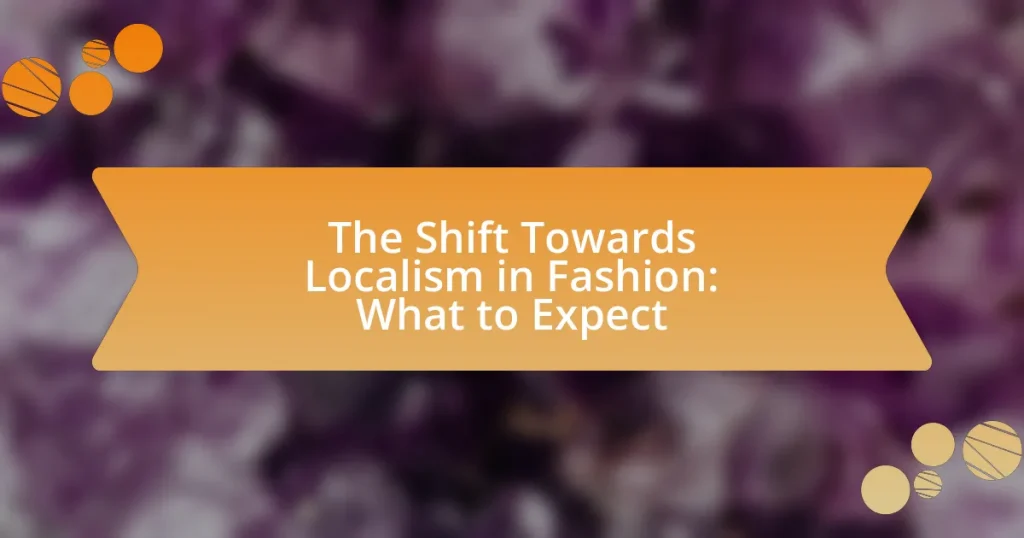The article explores the intersection of art and fashion, highlighting how designers like Alexander McQueen and Yves Saint Laurent have transformed clothing into wearable art by integrating artistic techniques and concepts. It examines the reciprocal influence between the two fields, showcasing historical collaborations, cultural movements, and key designers who challenge traditional fashion norms. The discussion includes the significance of consumer perception, the role of emerging technologies, and the importance of sustainability in this evolving landscape. Additionally, practical tips for aspiring designers on incorporating artistic influences and standing out in a competitive market are provided.
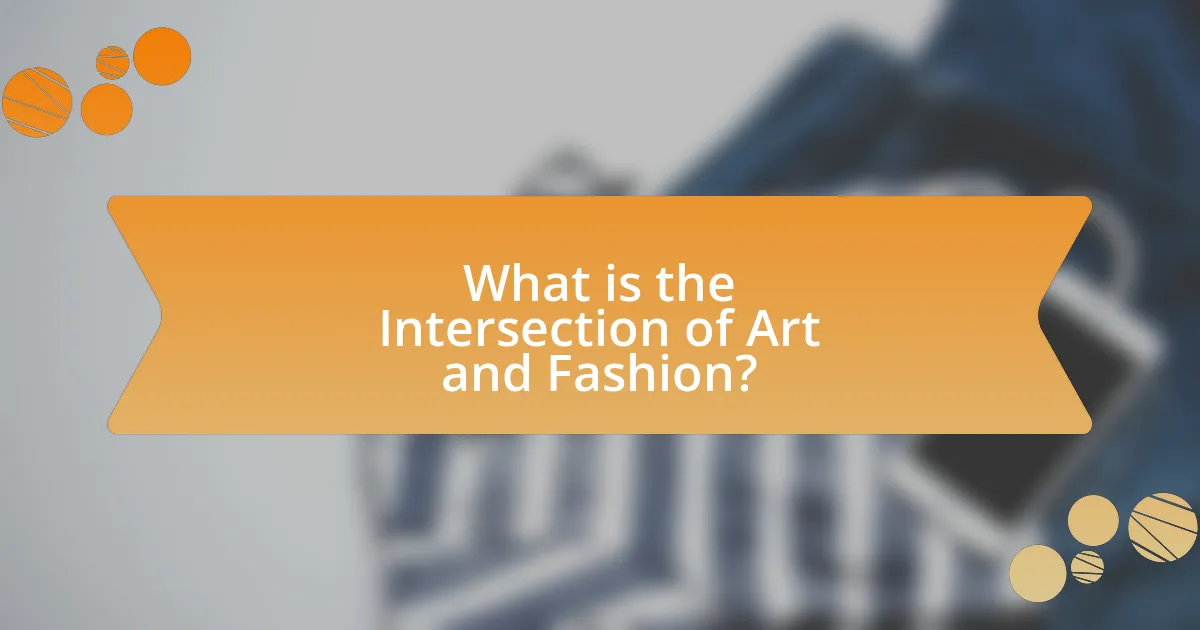
What is the Intersection of Art and Fashion?
The intersection of art and fashion refers to the blending of creative expression found in visual arts with the functional and aesthetic aspects of clothing design. This relationship is evident in the works of designers like Alexander McQueen and Yves Saint Laurent, who have incorporated artistic techniques and concepts into their collections, transforming garments into wearable art. For instance, McQueen’s collections often featured theatrical elements and intricate craftsmanship, while Saint Laurent’s designs drew inspiration from famous artists like Piet Mondrian, showcasing how fashion can serve as a canvas for artistic ideas. This convergence not only influences trends but also challenges traditional boundaries, allowing both fields to evolve and inspire one another.
How do art and fashion influence each other?
Art and fashion influence each other through a dynamic interplay where artistic movements inspire fashion trends and designers incorporate artistic elements into their collections. For instance, the Surrealist movement in the early 20th century significantly impacted fashion, with designers like Elsa Schiaparelli creating garments that reflected surrealist art, such as the famous Lobster Dress. Additionally, contemporary collaborations between artists and fashion brands, such as the partnership between Jeff Koons and Louis Vuitton, demonstrate how visual art can directly shape fashion aesthetics and marketing strategies. This reciprocal relationship highlights how both fields continuously evolve by drawing inspiration from one another, leading to innovative designs and cultural commentary.
What historical examples illustrate the connection between art and fashion?
Historical examples illustrating the connection between art and fashion include the collaboration between designer Elsa Schiaparelli and artist Salvador Dalí in the 1930s, which produced iconic pieces like the Lobster Dress, merging surrealism with haute couture. Another significant example is the influence of the Arts and Crafts Movement in the late 19th century, where designers like William Morris emphasized handcrafted textiles that reflected artistic values. Additionally, the 1960s saw the rise of Pop Art, with designers such as André Courrèges and Pierre Cardin incorporating bold colors and graphic designs inspired by artists like Andy Warhol. These instances demonstrate how fashion has historically drawn from artistic movements, creating a dynamic interplay between the two fields.
How have cultural movements shaped the relationship between art and fashion?
Cultural movements have significantly shaped the relationship between art and fashion by influencing aesthetic values, themes, and practices within both domains. For instance, the Dada movement in the early 20th century challenged traditional artistic norms and inspired fashion designers to adopt avant-garde styles that defied convention, leading to the emergence of surrealism in clothing design. Similarly, the punk movement of the 1970s utilized fashion as a form of political expression, with designers like Vivienne Westwood incorporating elements of art, such as collage and graffiti, into their collections. This interplay illustrates how cultural movements not only inspire artistic expression but also redefine fashion as a medium for social commentary and identity.
Why is the blending of art and fashion significant today?
The blending of art and fashion is significant today because it fosters innovation and cultural dialogue, allowing designers to express complex ideas and emotions through wearable art. This intersection enhances the visibility of artistic expression in everyday life, as seen in collaborations between renowned artists and fashion brands, such as the partnership between Louis Vuitton and Takashi Murakami, which merged high fashion with contemporary art aesthetics. Such collaborations not only elevate the status of fashion as a legitimate art form but also engage consumers in a deeper appreciation of both disciplines, reflecting societal trends and values.
What role does consumer perception play in this intersection?
Consumer perception significantly influences the intersection of art and fashion by shaping how individuals interpret and value the creative expressions within these domains. This perception affects purchasing decisions, as consumers often associate artistic elements in fashion with exclusivity, innovation, and cultural relevance. For instance, a study by the Fashion Institute of Technology found that 70% of consumers are more likely to purchase fashion items that they perceive as artful or unique, highlighting the impact of consumer perception on market trends and brand positioning.
How does the merging of these fields reflect societal changes?
The merging of art and fashion reflects societal changes by showcasing the evolving values of creativity, individuality, and cultural expression. This intersection highlights a shift towards a more inclusive and diverse representation in both fields, as seen in the rise of designers who incorporate social issues and personal narratives into their work. For example, the collaboration between artists and fashion designers, such as the partnership between Virgil Abloh and contemporary artists, illustrates how fashion is increasingly used as a medium for commentary on identity and social justice. This trend indicates a broader societal movement towards recognizing and valuing the interconnectedness of various forms of expression, ultimately reshaping consumer expectations and cultural dialogues.
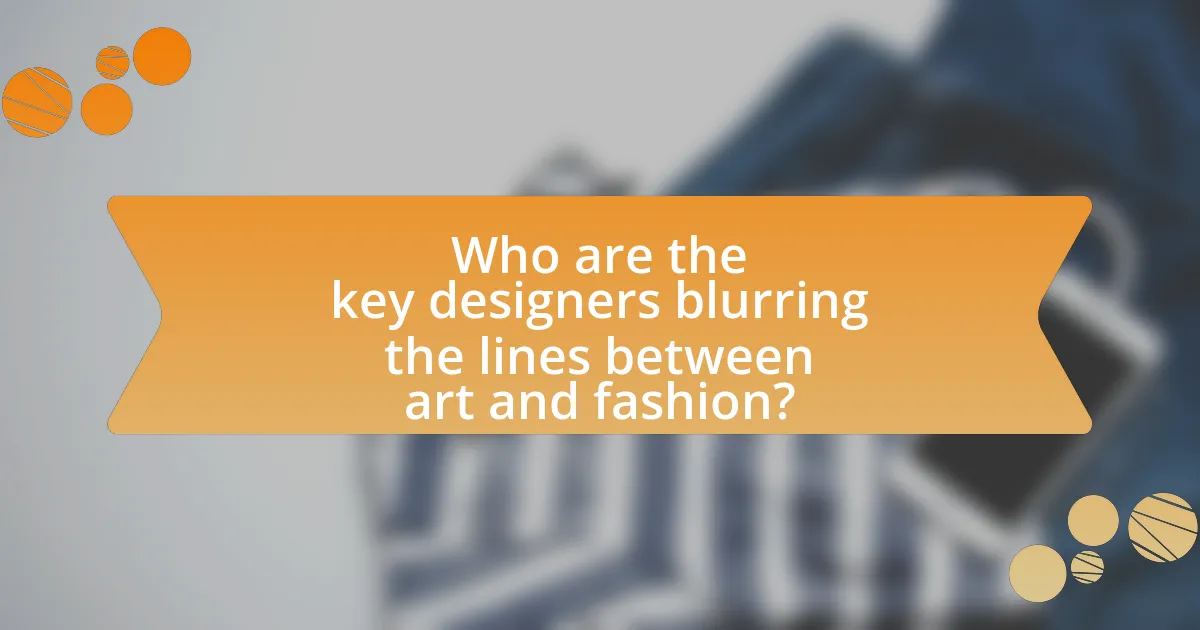
Who are the key designers blurring the lines between art and fashion?
Key designers blurring the lines between art and fashion include Alexander McQueen, Iris van Herpen, and Rei Kawakubo. Alexander McQueen is renowned for his theatrical runway shows that often incorporate elements of visual art, challenging traditional fashion norms. Iris van Herpen merges technology and craftsmanship, creating garments that resemble sculptures, thus redefining the boundaries of wearable art. Rei Kawakubo, founder of Comme des Garçons, is celebrated for her avant-garde designs that provoke thought and challenge conventional aesthetics, often drawing inspiration from contemporary art movements. These designers exemplify the fusion of artistic expression and fashion, making significant contributions to both fields.
What are the defining characteristics of these designers’ work?
The defining characteristics of these designers’ work include a seamless integration of artistic expression with functional fashion, often characterized by bold colors, innovative materials, and unconventional silhouettes. These designers frequently draw inspiration from various art movements, resulting in collections that challenge traditional fashion norms and provoke thought. For instance, designers like Alexander McQueen and Iris van Herpen have utilized techniques such as digital printing and sculptural forms to create garments that resemble wearable art, demonstrating a commitment to craftsmanship and creativity. This approach not only elevates the aesthetic value of their pieces but also invites dialogue about the relationship between art and everyday wear, reinforcing the notion that fashion can serve as a medium for artistic exploration.
How do these designers incorporate artistic elements into their fashion collections?
Designers incorporate artistic elements into their fashion collections by integrating visual art techniques, innovative materials, and thematic storytelling. For instance, designers like Alexander McQueen and Iris van Herpen utilize sculptural silhouettes and avant-garde techniques that reflect contemporary art movements, such as surrealism and biomimicry. This approach not only enhances the aesthetic appeal of their collections but also engages viewers on a conceptual level, transforming garments into wearable art. The use of collaborations with visual artists, as seen in the works of designers like Jean-Paul Gaultier, further exemplifies this integration, where fashion pieces are inspired by paintings or installations, creating a dialogue between the two disciplines.
What are some notable collaborations between artists and fashion designers?
Notable collaborations between artists and fashion designers include the partnership between Jean-Paul Gaultier and artist Andy Warhol, which resulted in collections inspired by Warhol’s iconic pop art. Another significant collaboration is between fashion designer Alexander McQueen and artist Damien Hirst, where Hirst’s artwork was featured on McQueen’s clothing, merging high fashion with contemporary art. Additionally, the collaboration between fashion house Louis Vuitton and artist Takashi Murakami produced a line of handbags that combined luxury fashion with vibrant, playful art, significantly impacting both industries. These collaborations exemplify how artists and designers can create innovative and culturally relevant works that resonate with audiences.
How do these designers challenge traditional fashion norms?
Designers challenge traditional fashion norms by incorporating unconventional materials, innovative silhouettes, and cultural narratives into their collections. For instance, designers like Alexander McQueen and Iris van Herpen utilize technology and craftsmanship to create garments that defy standard construction methods, pushing the boundaries of what clothing can represent. Additionally, they often address social issues through their work, such as gender fluidity and sustainability, which contrasts sharply with the conventional fashion industry’s focus on seasonal trends and commercial viability. This approach not only redefines aesthetics but also invites critical discourse on the role of fashion in society.
What innovative techniques do they use to merge art with fashion?
Designers merge art with fashion through techniques such as digital printing, collaboration with visual artists, and the use of unconventional materials. Digital printing allows for intricate designs and artworks to be directly applied to fabrics, enabling unique visual expressions. Collaborations with visual artists, like the partnership between fashion brands and contemporary artists, result in limited-edition collections that showcase artistic creativity on wearable items. Additionally, the incorporation of unconventional materials, such as recycled plastics or 3D-printed elements, challenges traditional fashion norms and emphasizes artistic innovation. These methods exemplify how the boundaries between art and fashion are increasingly blurred, creating a dynamic interplay that enhances both fields.
How do their designs provoke thought and discussion in the fashion industry?
Designers provoke thought and discussion in the fashion industry by integrating artistic concepts and social commentary into their collections. This approach challenges traditional notions of fashion, prompting audiences to engage with deeper themes such as identity, culture, and sustainability. For instance, designers like Alexander McQueen and Vivienne Westwood have used their platforms to address issues like consumerism and environmental impact, sparking conversations that extend beyond aesthetics. The incorporation of provocative imagery and unconventional materials further stimulates debate, as seen in McQueen’s “Plato’s Atlantis” collection, which explored themes of evolution and climate change. Such designs not only captivate attention but also encourage critical reflection on the role of fashion in society.
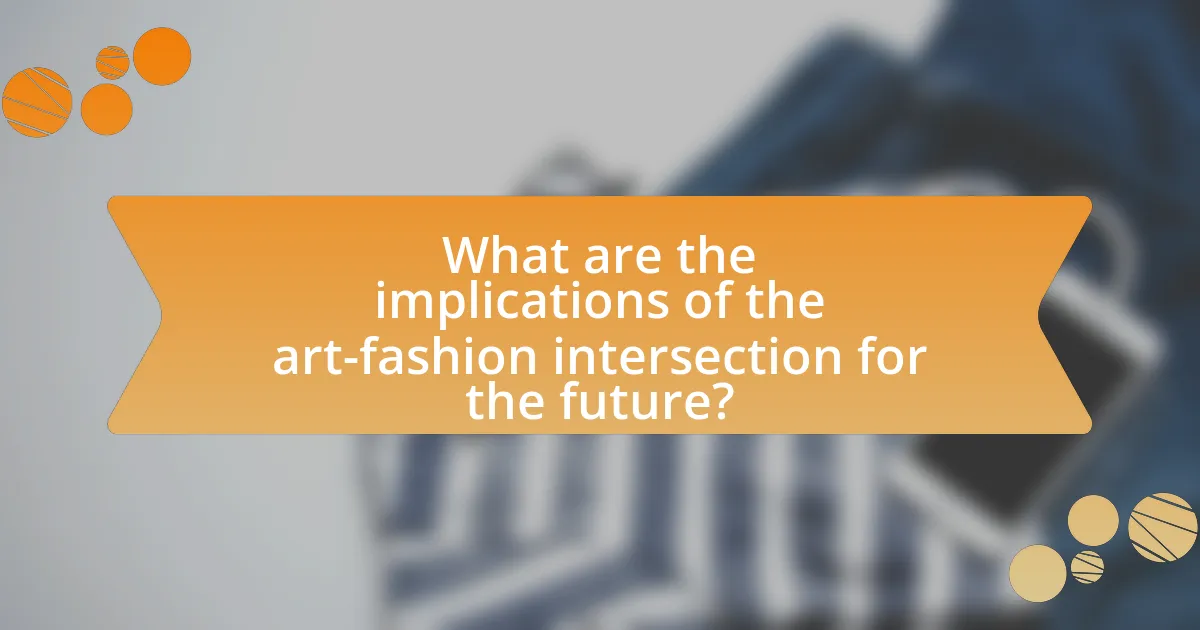
What are the implications of the art-fashion intersection for the future?
The implications of the art-fashion intersection for the future include the potential for innovative design, increased collaboration between artists and fashion designers, and a shift in consumer perception towards valuing artistic expression in clothing. This intersection fosters a creative environment where fashion can serve as a canvas for artistic ideas, leading to unique collections that challenge traditional aesthetics. For instance, collaborations like those between fashion houses and contemporary artists, such as the partnership between Louis Vuitton and Takashi Murakami, demonstrate how art can elevate fashion into a form of cultural commentary. As consumers increasingly seek authenticity and individuality, the blending of art and fashion is likely to redefine market trends, encouraging brands to adopt more artistic approaches in their offerings.
How might this trend evolve in the coming years?
The trend of designers blurring the lines between art and fashion is likely to evolve towards greater collaboration and integration, as evidenced by the increasing number of partnerships between artists and fashion brands. For instance, high-profile collaborations, such as those between Louis Vuitton and Takashi Murakami, have demonstrated the commercial viability and cultural impact of merging these two fields. Additionally, the rise of digital art and NFTs is expected to further influence this trend, allowing designers to explore new mediums and reach broader audiences. As consumer demand for unique and personalized fashion experiences grows, designers will increasingly adopt artistic elements to differentiate their offerings, leading to a more dynamic and innovative landscape in both art and fashion.
What emerging technologies could influence the fusion of art and fashion?
Emerging technologies such as augmented reality (AR), virtual reality (VR), artificial intelligence (AI), and blockchain are significantly influencing the fusion of art and fashion. AR and VR enable immersive experiences that allow consumers to interact with fashion pieces as art installations, enhancing engagement and appreciation. AI is revolutionizing design processes by analyzing trends and generating unique patterns, which can lead to innovative collaborations between artists and fashion designers. Blockchain technology ensures authenticity and provenance in art and fashion, fostering trust and transparency in the market. These technologies are reshaping how art and fashion coexist, creating new avenues for expression and commerce.
How can sustainability be integrated into this intersection?
Sustainability can be integrated into the intersection of art and fashion by promoting the use of eco-friendly materials and ethical production practices. Designers can source organic fabrics, recycled materials, and non-toxic dyes, which reduce environmental impact and promote responsible consumption. For instance, brands like Stella McCartney have successfully implemented sustainable practices by using innovative materials such as vegan leather and recycled polyester, demonstrating that high fashion can align with ecological responsibility. This approach not only minimizes waste but also encourages consumers to value sustainability in their purchasing decisions, fostering a culture of environmental awareness within the fashion and art communities.
What practical tips can aspiring designers take from this intersection?
Aspiring designers can take several practical tips from the intersection of art and fashion, primarily focusing on the integration of creativity and technical skills. First, they should explore diverse artistic influences, as many successful designers draw inspiration from various art movements, which can enhance their unique style. For instance, designers like Alexander McQueen have incorporated elements from surrealism and romanticism into their collections, demonstrating how art can inform fashion design.
Second, aspiring designers should prioritize experimentation with materials and techniques. Engaging in mixed media projects can lead to innovative designs that challenge traditional fashion norms. For example, the use of unconventional materials, as seen in the works of designers like Iris van Herpen, can create striking visual effects and push the boundaries of wearable art.
Lastly, networking with artists and participating in collaborative projects can provide valuable insights and broaden a designer’s perspective. Collaborations, such as those between fashion brands and contemporary artists, often result in unique collections that resonate with a wider audience, showcasing the power of interdisciplinary approaches in design.
How can they effectively incorporate artistic influences into their work?
Designers can effectively incorporate artistic influences into their work by studying various art movements and integrating their principles into fashion design. This approach allows designers to draw inspiration from color palettes, textures, and forms found in art, which can enhance the visual appeal and conceptual depth of their collections. For instance, the use of abstract expressionism can lead to bold, spontaneous designs, while elements of surrealism can inspire innovative silhouettes. Historical examples include the collaboration between fashion designer Yves Saint Laurent and artist Piet Mondrian, where the designer translated the artist’s geometric patterns into wearable art, demonstrating the successful fusion of artistic influences into fashion.
What strategies can they use to stand out in a competitive market?
Designers can stand out in a competitive market by leveraging unique artistic collaborations and innovative storytelling. By partnering with artists from various disciplines, designers can create exclusive collections that merge fashion with visual art, attracting attention and differentiating their brand. For instance, collaborations like those between fashion houses and contemporary artists have resulted in limited-edition pieces that not only showcase creativity but also enhance brand visibility. Additionally, employing storytelling through marketing campaigns that highlight the artistic process and inspiration behind collections can engage consumers on a deeper level, fostering brand loyalty and interest. This approach is supported by the fact that brands that effectively communicate their unique narratives often see increased consumer engagement and sales, as evidenced by successful campaigns from brands like Gucci and Louis Vuitton.
